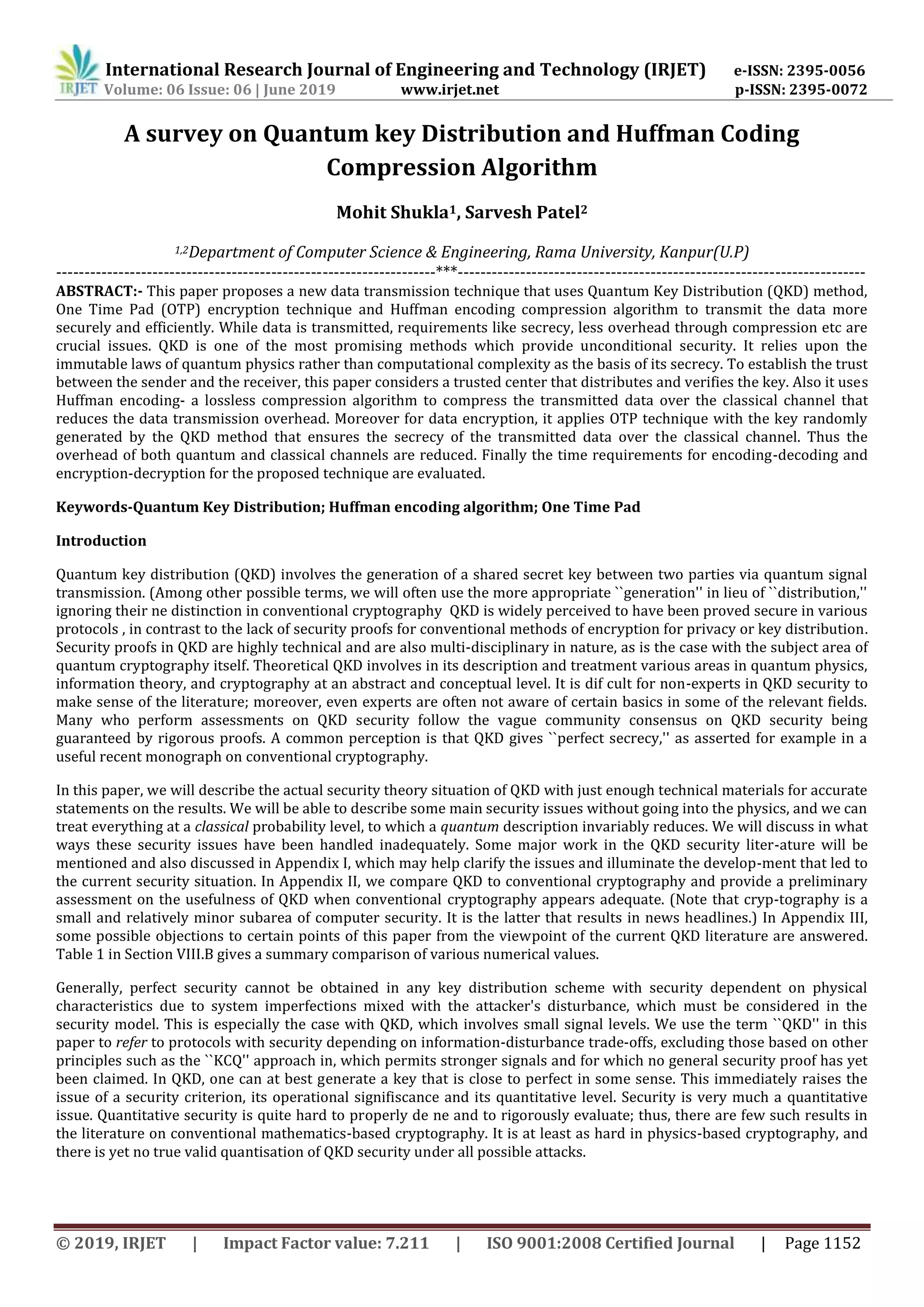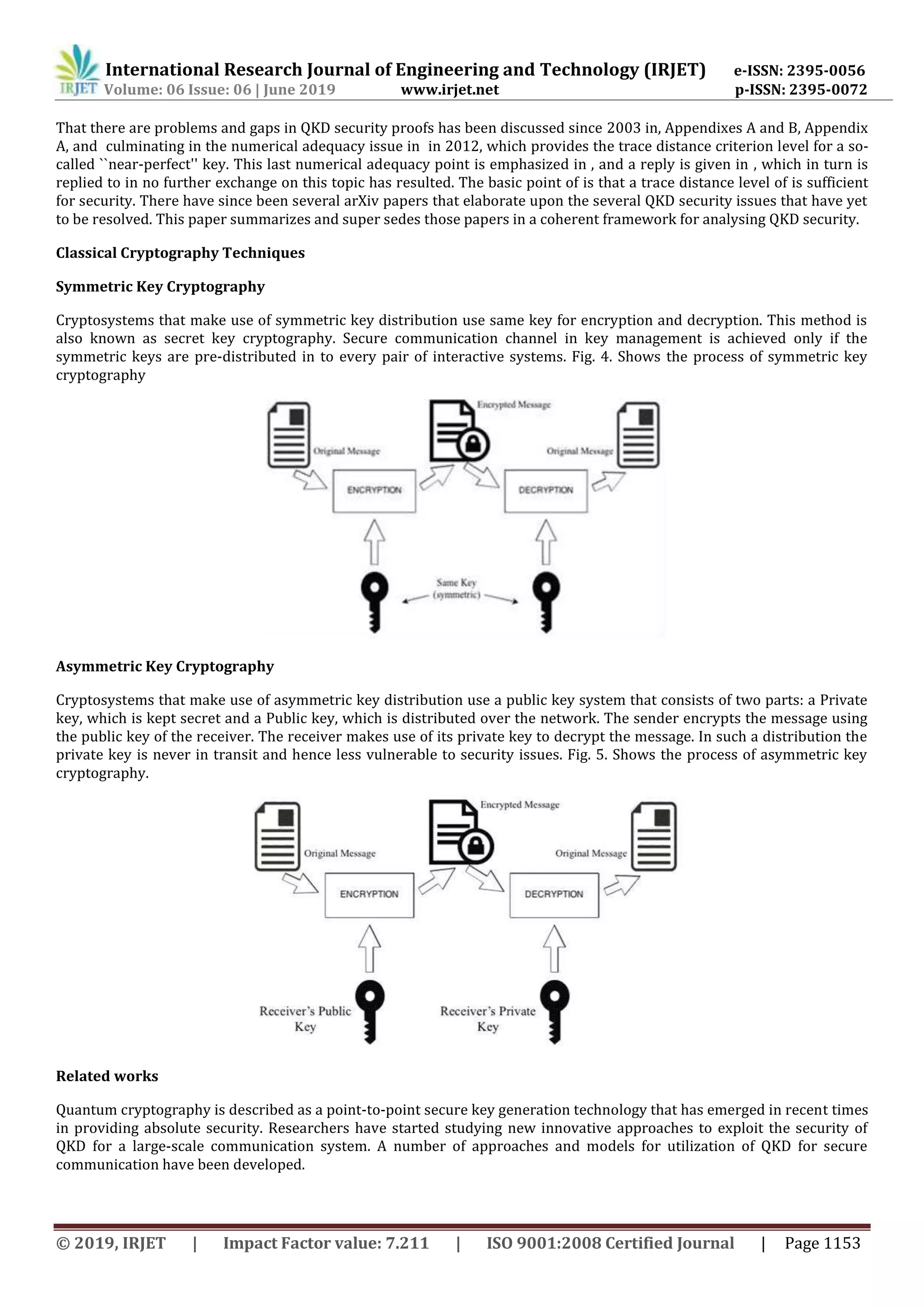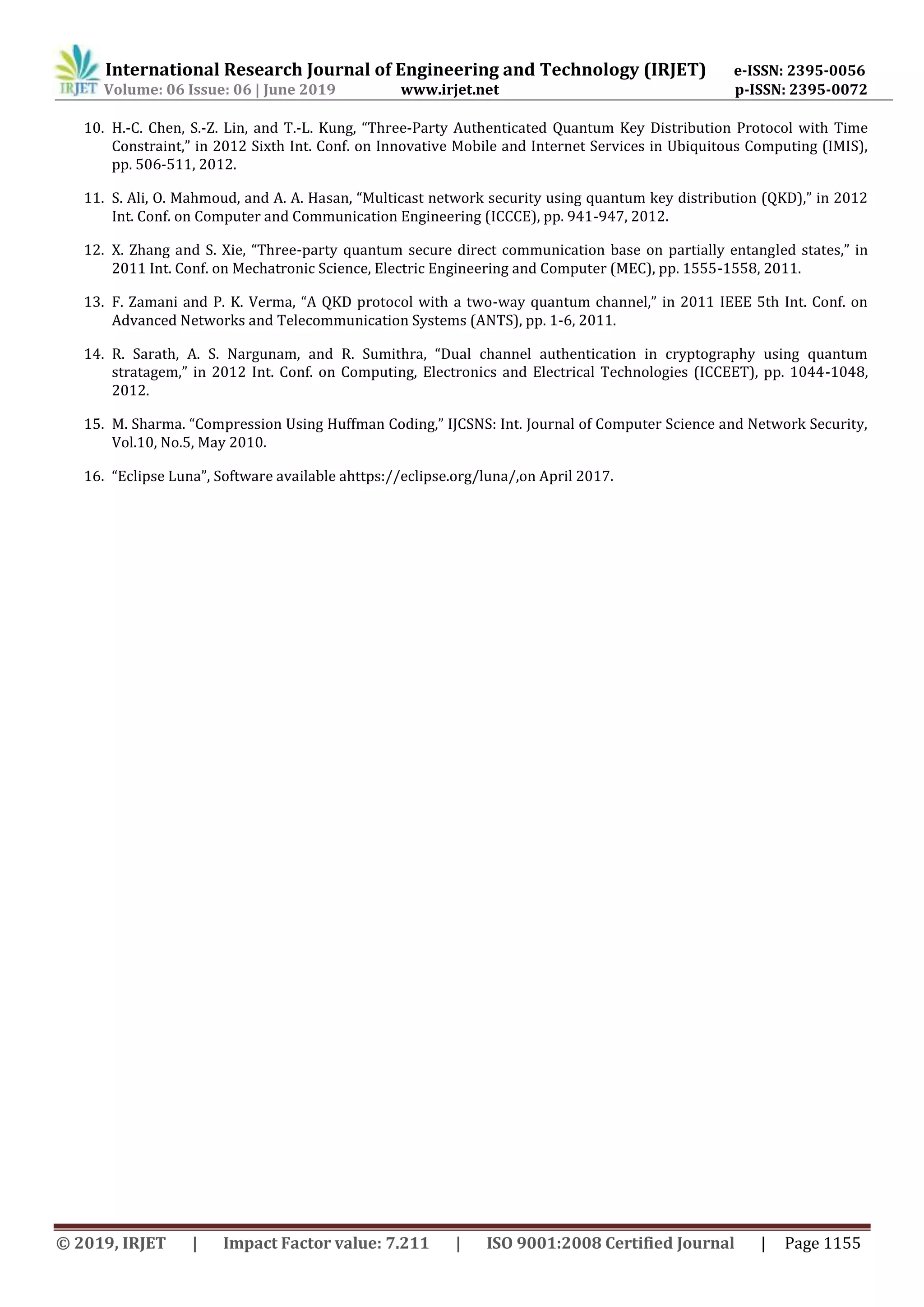This document discusses a proposed technique for more securely and efficiently transmitting data that uses quantum key distribution (QKD), one-time pad encryption, and Huffman encoding compression. QKD is used to randomly generate encryption keys that provide unconditional security. Huffman encoding compresses the data to reduce transmission overhead. The one-time pad technique encrypts the data with the randomly generated keys, ensuring secrecy over the classical channel. Experimental results show that encryption and decompression times increase with larger data sizes as expected. The proposed technique is concluded to provide better secrecy and efficiency than related methods by making decryption difficult without the proper keys.


![International Research Journal of Engineering and Technology (IRJET) e-ISSN: 2395-0056 Volume: 06 Issue: 06 | June 2019 www.irjet.net p-ISSN: 2395-0072 © 2019, IRJET | Impact Factor value: 7.211 | ISO 9001:2008 Certified Journal | Page 1154 The uncertainty principle in quantum mechanics created a new paradigm for QKD [21]. One of the approaches for use of QKD involved network fashioned security. BBN DARPA quantum network is an example of such network. Researchers at Boston, Harvard University, and BBN technologies jointly developed the DARPA Quantum Network in 2004 [14]. The main goal was point-to-point Quantum network that exploited QKD technology for end-to-end network security via high speed QKD. Other approaches and models equipped with QKD in network fashion are introduced in the literature as, A different approach that this paper deals with is using QKD in existing protocols, which are widely used on the Internet to enhance security with main objective of unconditional security. Papers present models and schemes to integrate QKD in classical security protocols like IPsec, PPP and TLS. Experimental Results and Discussions Employing the proposed technique, the time requirement for compression-decompression is presented. Also the time requirement for encryption-decryption is presented. Here, plaintexts with different lengths are chosen to depict the result. In both cases, when the size of the data increases, the time requirement also increases and it is easily observable from the figures. It also shows that for the proposed technique, the time requirement of decompression is larger than that of compression while the size of the plaintext increases. It also shows that for the proposed technique, the time requirement of decryption is larger than that of encryption. Conclusions The proposed data transmission technique based on QKD along with Huffman coding compression algorithm and OTP enriches the level secrecy and efficiency of the transmitted data. Here to breach the security of ciphertext, the attacker needs to perform all possible combinations of checking before breaching the secrecy of the data which is expected to be quite difficult. The reason is, the decryption of data of the proposed technique relies on the strength of Huffman algorithm, along with OTP in which the key is generated randomly using QKD. For this reason the proposed technique ensures better secrecy and efficiency than other related techniques, and it is powerful against intruders and eavesdroppers. The main concern of this work is to ensure secrecy and efficiency while data transmission. Over the classical channel, the use of OTP makes the data more secure and the use of Huffman algorithm makes the data transmission faster i.e. efficient. Reference 1. K. S. Kabir, T. Chakraborty, and A.B.M. Alim Al Islam, “SuperCrypt: A Technique for Quantum Cryptography through Simultaneously Improving Both Security Level and Data Rate”, Proc. of 2016 Int. Conf. on Networking Systems and Security, pp. 25-33, 2016. 2. D. Bruss, G. Erdelyi, T. Meyer, T. Riege, and J. Rothe, “Quantum cryptography: A survey,” ACM Computing Surveys (CSUR), Vol. 39, No. 2, pp. 1-27, 2007. 3. W. K. Wootters and W. H. Zurek, “A single quantum cannot be cloned,” Nature, Vol. 299, pp. 802-803, 1982. 4. N. S. Yanofsky and M. A. Mannucci, “Quantum computing for computer scientists,” Vol. 20, Cambridge University Press, 2008. 5. M. Alshowkan, K. Elleithy, A. Odeh, and E. Abdelfattah, “A new algorithm for three-party Quantum key distribution,” in 2013 IEEE 3rd Int. Conf. on Innovative Computing Technology (INTECH), pp. 208-212, August, 2013. 6. A. K. Ekert, “Quantum cryptography based on Bell’s theorem,” Physical review letters, 67.6, pp. 661-663, 1991. 7. C. H. Bennett and G. Brassard, “Quantum cryptography: Public key distribution and coin tossing,” in Proceedings of IEEE Int. Conf. on Computers,Systems and Signal Processing, 1984. 8. Z. Quan and T. Chaojing, “Simple proof of the unconditional security of the Bennett 1992 quantum key distribution protocol,” Physical Review A, Vol. 65, No. 6, p. 062301, 2002. 9. D. Gottesman and J. Preskill, “Secure quantum key distribution using squeezed states,” Physical Review A, vol. 63, p. 022309, 2001.](https://image.slidesharecdn.com/irjet-v6i6293-191118054414/75/IRJET-A-Survey-on-Quantum-Key-Distribution-and-Huffman-Coding-Compression-Algorithm-3-2048.jpg)
